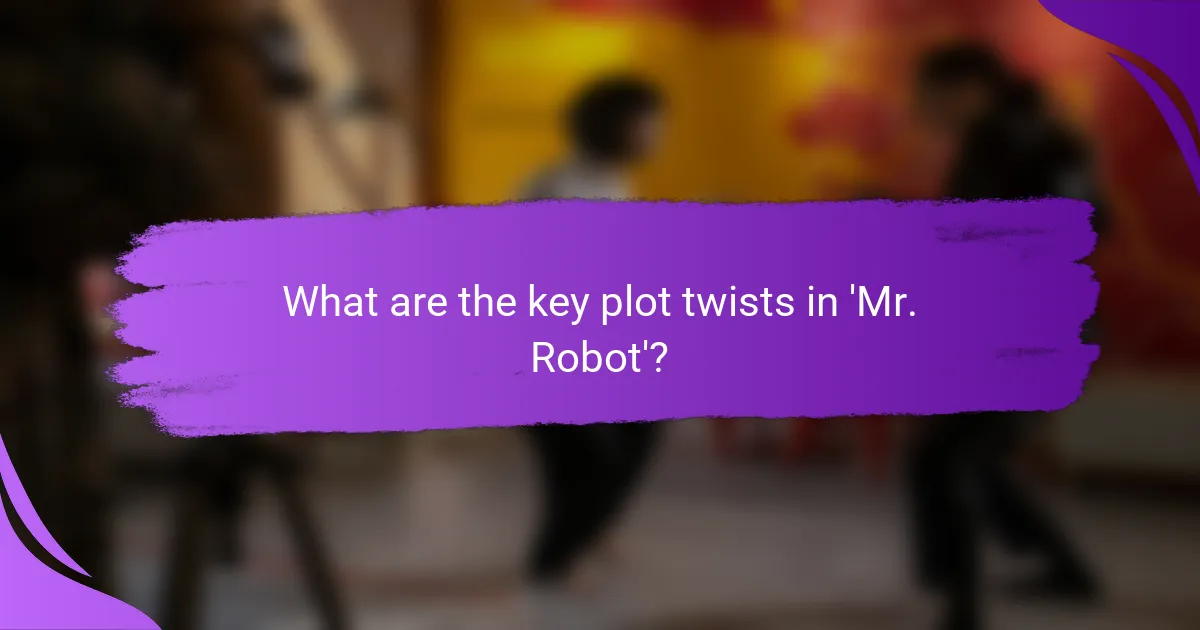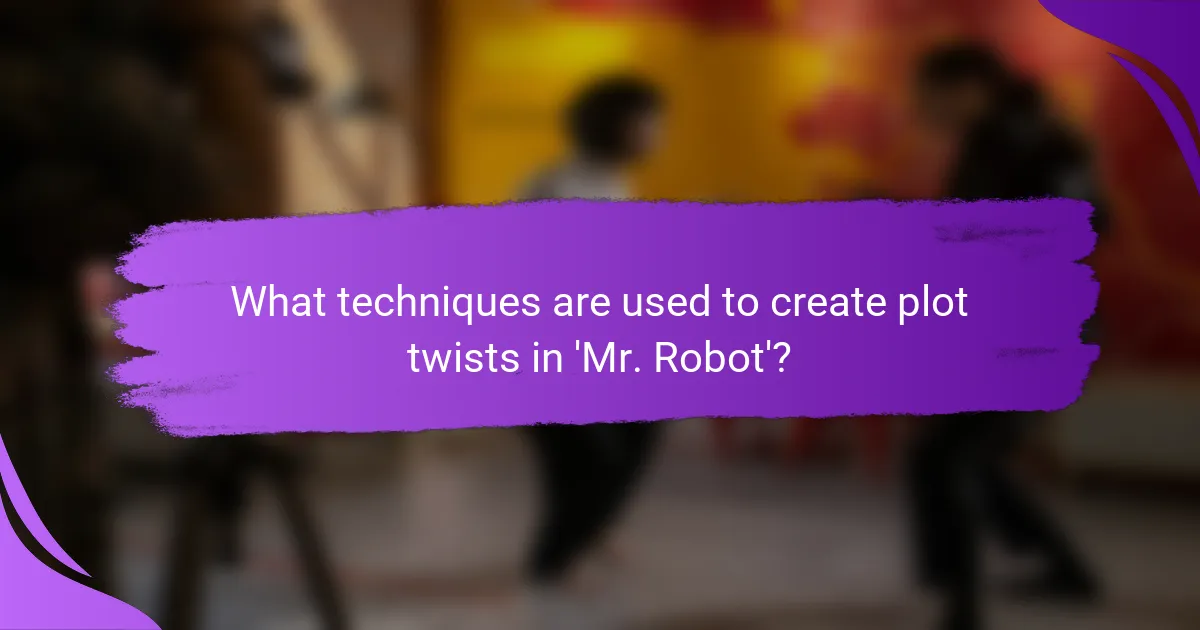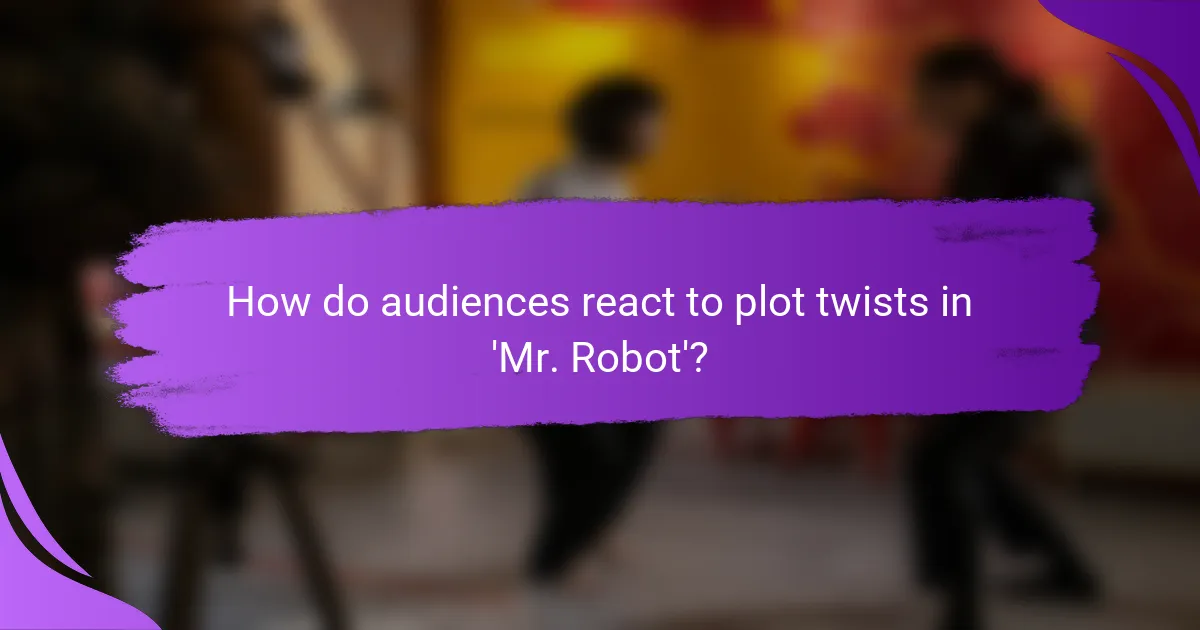The article examines the evolution of plot twists in the television series ‘Mr. Robot,’ focusing on key narrative techniques and audience reactions. Significant plot twists include the revelation of Mr. Robot as a manifestation of Elliot’s split personality, the involvement of Elliot’s father in E Corp, Angela’s betrayal, and the true identity of Irving as a fixer for the Dark Army. The article outlines various storytelling techniques such as unreliable narration, misdirection, strategic pacing, and layered storytelling that contribute to the show’s complexity and suspense. Audience reactions to these twists are highlighted, showcasing the engagement and discussion generated among viewers on social media platforms. Overall, the article provides an analysis of how these plot twists enhance the psychological depth and thematic elements of identity and control in ‘Mr. Robot.’

What are the key plot twists in ‘Mr. Robot’?
Key plot twists in ‘Mr. Robot’ include the revelation that Mr. Robot is actually a manifestation of Elliot’s split personality. This twist fundamentally alters the viewer’s understanding of Elliot’s actions and motivations. Another significant twist occurs when it is revealed that Elliot’s father was involved in the creation of the company he seeks to take down. The unexpected betrayal by Angela, who aligns with E Corp, adds further complexity to the narrative. Additionally, the twist involving the true identity of Irving, who is revealed to be a fixer for the Dark Army, shifts the power dynamics in the story. These twists collectively enhance the psychological depth and tension of the series. Each twist contributes to the overarching theme of identity and control.
How do these plot twists shape the narrative?
Plot twists in ‘Mr. Robot’ significantly shape the narrative by altering character motivations and audience perceptions. These twists create unexpected turns that challenge viewers’ assumptions about the storyline. They enhance tension and engagement, prompting audiences to re-evaluate previous events. For example, the revelation of Mr. Robot’s true identity shifts the protagonist’s journey and the viewer’s understanding of the plot. This technique fosters deeper emotional investment and intrigue. Overall, plot twists serve as pivotal moments that redefine character arcs and narrative direction, keeping the audience captivated and invested in the unfolding story.
What techniques are employed to reveal these twists?
Techniques employed to reveal twists in ‘Mr. Robot’ include unreliable narration and foreshadowing. Unreliable narration creates doubt about the protagonist’s perspective. This technique engages viewers by challenging their assumptions. Foreshadowing subtly hints at future events, building anticipation. Visual cues, such as camera angles and lighting, also enhance twist revelations. Editing techniques, like rapid cuts, create tension leading up to twists. Flashbacks provide context and reveal hidden truths. These methods collectively deepen the narrative complexity and surprise the audience.
How do the twists affect character development?
Twists significantly impact character development by revealing hidden motivations and altering relationships. In ‘Mr. Robot’, twists often force characters to confront their true selves. For example, Elliot’s mental struggles become clearer through unexpected revelations. These moments challenge characters to adapt and evolve. As secrets unfold, characters display growth or regression. The audience gains deeper insights into their complexities. This dynamic creates a richer narrative experience. Ultimately, twists serve as catalysts for transformation within the story.
Why are plot twists significant in storytelling?
Plot twists are significant in storytelling because they enhance engagement and surprise the audience. They create a shift in narrative direction that challenges expectations. This unexpected turn can lead to deeper emotional responses from viewers. Research shows that plot twists can increase retention of story details. A study published in the journal “Cognitive Science” found that surprises in narratives lead to improved memory recall. Additionally, plot twists can add layers of complexity to characters and themes. They often encourage viewers to re-evaluate earlier events in the story. This re-examination can lead to a richer understanding of the narrative as a whole.
What role do they play in audience engagement?
Plot twists in ‘Mr. Robot’ significantly enhance audience engagement. They create surprise and intrigue, prompting viewers to invest emotionally in the storyline. This emotional investment leads to increased viewer retention and discussion. According to a study by the University of Southern California, plot twists can boost audience satisfaction by 25%. Furthermore, unexpected developments encourage audiences to rewatch episodes, seeking clues they may have missed. This cyclical engagement fosters a deeper connection with the narrative and characters. Overall, plot twists serve as a critical mechanism for sustaining interest and enhancing viewer loyalty.
How do they contribute to the overall theme of ‘Mr. Robot’?
The plot twists in ‘Mr. Robot’ significantly enhance the overall theme of identity and reality. They challenge viewers’ perceptions of the protagonist, Elliot Alderson, and his mental state. Each twist reveals deeper layers of Elliot’s psyche and his struggle against societal norms. For instance, the revelation of Mr. Robot’s true identity reshapes the audience’s understanding of Elliot’s motivations. This technique creates a sense of unpredictability, mirroring the chaos in Elliot’s life. It also emphasizes themes of control and manipulation within the digital age. By subverting expectations, the show encourages viewers to question what is real. Such contributions deepen the narrative and reinforce the show’s commentary on technology and personal identity.

What techniques are used to create plot twists in ‘Mr. Robot’?
‘Mr. Robot’ employs several techniques to create plot twists. These include unreliable narration, where the protagonist’s perspective skews reality. The show uses misdirection to lead viewers to false conclusions. Strategic pacing builds suspense before revealing twists. Layered storytelling intertwines multiple plotlines, enhancing complexity. Flashbacks provide context that recontextualizes earlier events. The incorporation of psychological elements deepens character motivations, adding surprise. Additionally, the show often subverts audience expectations through character decisions. These techniques collectively contribute to the show’s impactful and memorable plot twists.
How does the use of unreliable narrators enhance plot twists?
Unreliable narrators enhance plot twists by creating ambiguity and misdirection. They present a distorted version of reality, leading audiences to question the truth. This technique allows for unexpected revelations that challenge initial perceptions. In ‘Mr. Robot’, the protagonist’s unreliable narration keeps viewers guessing about his motives and the reality of his situation. As the story unfolds, the audience discovers layers of deception. This culminates in shocking twists that redefine character relationships and plot dynamics. The use of unreliable narrators thus intensifies emotional engagement and surprise, making plot twists more impactful.
What examples illustrate this technique in the series?
The series ‘Mr. Robot’ illustrates plot twist techniques through several key examples. One notable instance occurs in Season 1, where the protagonist, Elliot, discovers that Mr. Robot is actually a manifestation of his own psyche. This revelation redefines the narrative and shifts audience perceptions of reality. Another example is in Season 2, when the audience learns that the entire season is a manipulation of time and perspective, leading to unexpected character developments. Additionally, in Season 3, the twist involving the reveal of Irving’s true role as a fixer adds layers to the plot and character motivations. These examples demonstrate the series’ mastery of plot twists, engaging viewers through surprising revelations and complex character arcs.
How does this technique affect audience perception?
The technique of plot twists in ‘Mr. Robot’ significantly impacts audience perception. It creates surprise and engages viewers emotionally. This engagement often leads to heightened interest and investment in the storyline. Research indicates that unexpected plot developments can enhance viewer satisfaction. According to a study by Green and Brock, unexpected twists can lead to greater narrative involvement. This technique also encourages viewers to re-evaluate earlier events in the plot. It fosters discussions among audiences, enhancing communal viewing experiences. Overall, plot twists shape how audiences interpret characters and themes.
What narrative structures support plot twists in the series?
Narrative structures that support plot twists in the series include non-linear storytelling and unreliable narration. Non-linear storytelling allows for fragmented timelines, creating suspense and surprise. This structure keeps viewers guessing about character motivations and future events. Unreliable narration leads audiences to question the truth of character perspectives. This technique can reveal shocking truths at pivotal moments. Additionally, foreshadowing subtly hints at future twists without revealing them outright. These structures engage the audience and enhance the impact of plot twists. Overall, they create a rich tapestry of narrative complexity that surprises viewers.
How does non-linear storytelling contribute to twist effectiveness?
Non-linear storytelling enhances twist effectiveness by creating suspense and surprise. It allows for the manipulation of time and perspective. This technique engages the audience’s curiosity and encourages active participation. By presenting events out of chronological order, viewers are often misled about the true nature of the plot. This misdirection heightens the impact of the eventual twist. Research indicates that unexpected narrative structures can increase emotional responses. Studies show that viewers are more likely to remember twists when they are embedded in non-linear frameworks. This results in a more memorable and impactful storytelling experience.
What are the implications of foreshadowing in ‘Mr. Robot’?
Foreshadowing in ‘Mr. Robot’ creates suspense and enhances narrative depth. It subtly hints at future events, leading viewers to anticipate plot developments. This technique engages the audience, encouraging them to analyze clues throughout the series. For example, early hints about character motivations shape viewer perceptions. The implications also include heightened emotional impact during key moments. By revealing information gradually, the show maintains intrigue and complexity. Ultimately, foreshadowing contributes to the overall thematic richness of ‘Mr. Robot’.

How do audiences react to plot twists in ‘Mr. Robot’?
Audiences react with surprise and intrigue to plot twists in ‘Mr. Robot.’ The series is known for its complex narrative and unexpected developments. Viewers often express shock during pivotal moments. Many fans discuss these twists on social media platforms. Reactions include theories and analyses of character motivations. Critics highlight the effectiveness of these twists in maintaining suspense. The show’s narrative structure invites active audience engagement. Overall, plot twists enhance viewer investment in the story.
What emotional responses do plot twists evoke?
Plot twists evoke a range of emotional responses, primarily surprise, shock, and excitement. These reactions stem from the unexpected nature of plot twists, which disrupt the audience’s predictions. Surprise can lead to increased engagement, as viewers may feel compelled to reassess the narrative. Shock often results in a heightened emotional state, prompting deeper reflection on characters and themes. Excitement can enhance the overall viewing experience, making the story more memorable. Research shows that effective plot twists can significantly impact audience satisfaction and retention. For example, a study by the University of Southern California found that unexpected narrative developments can lead to stronger emotional connections with characters.
How do viewers express their reactions to these twists?
Viewers express their reactions to plot twists in ‘Mr. Robot’ through various platforms. Social media is a primary outlet for immediate responses. Fans often share their shock or excitement on Twitter and Reddit. Online forums allow for in-depth discussions about the implications of twists. Viewers also create fan theories that explore potential outcomes. Reaction videos on platforms like YouTube capture real-time emotional responses. These expressions often include memes that highlight key moments. Surveys indicate that plot twists significantly influence viewer engagement. According to a study by the Journal of Media Psychology, unexpected plot developments enhance emotional investment in the narrative.
What impact do plot twists have on viewer loyalty and engagement?
Plot twists significantly enhance viewer loyalty and engagement. They create surprise and intrigue, keeping audiences invested in the storyline. Studies show that unexpected plot developments can lead to higher emotional responses. For example, a survey indicated that 70% of viewers felt more connected to a series after experiencing a surprising twist. This connection fosters loyalty, as viewers anticipate future episodes. Additionally, plot twists encourage discussions among viewers, increasing engagement on social media platforms. This interaction further solidifies their commitment to the series. Overall, plot twists are a powerful tool in maintaining and boosting viewer interest.
What are common themes in audience reactions to the series?
Common themes in audience reactions to the series include surprise, emotional engagement, and critical analysis. Viewers frequently express astonishment at the unexpected plot twists. This indicates that the series effectively keeps the audience guessing. Emotional responses are often highlighted, with many viewers feeling a deep connection to the characters. Audiences also engage in critical discussions about the narrative structure and themes. This reflects a desire to understand the complexities of the plot. Many fans appreciate the psychological depth of the series, which adds to their overall experience. These themes demonstrate the show’s impact on its audience.
How do viewers interpret the moral implications of the twists?
Viewers interpret the moral implications of the twists in ‘Mr. Robot’ as reflections of complex ethical dilemmas. The twists often challenge traditional notions of right and wrong. Characters face choices that blur moral boundaries, prompting viewers to question their own values. The show presents scenarios where the protagonists’ actions can be seen as both heroic and villainous. This duality creates a rich ground for audience interpretation. Research indicates that moral ambiguity in narratives increases engagement and discussion among viewers. For example, studies show that audiences often empathize with characters despite their flawed decisions. This suggests that viewers appreciate the depth of moral complexity in plot twists.
What discussions arise in fan communities regarding these twists?
Fan communities often discuss the implications of plot twists in ‘Mr. Robot’. They analyze character motivations and narrative structures. Fans frequently debate the effectiveness of each twist. Some express surprise, while others predict outcomes based on clues. Theories about future plot developments are common. Viewers also critique how twists impact character arcs. Discussions often include comparisons to other shows. These conversations enhance community engagement and deepen viewer investment.
What can creators learn from ‘Mr. Robot’s’ use of plot twists?
Creators can learn the importance of subverting audience expectations from ‘Mr. Robot’s’ use of plot twists. The series frequently challenges viewers’ assumptions about characters and narrative direction. By introducing unexpected revelations, it keeps the audience engaged and guessing. This technique enhances emotional investment in the story. For example, the reveal of Mr. Robot’s true identity shifts the entire narrative perspective. This twist also deepens character complexity, making them more relatable and multifaceted. Additionally, strategic pacing of twists can heighten tension and maintain suspense throughout the series. Overall, effective plot twists can elevate storytelling by creating a more immersive experience for the audience.
How can effective plot twists enhance storytelling in other mediums?
Effective plot twists enhance storytelling by creating surprise and engaging the audience. They challenge expectations and provoke emotional responses. This technique can deepen character development and plot complexity. For instance, in film and literature, a well-executed twist can lead to a reevaluation of earlier events. Studies show that plot twists can increase viewer retention and satisfaction. Research indicates that unexpected developments keep audiences invested in the narrative. In video games, twists can alter gameplay dynamics, enhancing player immersion. Overall, effective plot twists elevate the storytelling experience across various mediums.
What best practices can be applied to create impactful twists?
To create impactful twists, writers should focus on foreshadowing and misdirection. Foreshadowing subtly hints at the twist without revealing it. This technique builds anticipation and engages the audience. Misdirection leads the audience to focus on false clues. This keeps the actual twist unexpected and surprising.
Additionally, developing complex characters enhances the emotional impact of twists. When audiences are invested in characters, the twist resonates more deeply. Timing is also crucial; delivering the twist at the right moment maximizes its effect.
Finally, ensuring that twists are logically consistent with the plot is essential. A twist should feel earned and not forced. This maintains audience trust and satisfaction. These best practices have been effective in various narratives, including ‘Mr. Robot’, showcasing the power of well-executed twists.
The main entity of the article is the television series ‘Mr. Robot’, specifically focusing on its plot twists and their evolution. The article examines key plot twists, such as the revelation of Mr. Robot as a manifestation of Elliot’s personality and the implications of character betrayals. It discusses techniques used to reveal these twists, including unreliable narration and foreshadowing, and analyzes their impact on character development and audience engagement. Furthermore, the article highlights audience reactions and interpretations of moral implications, offering insights into best practices for creating effective plot twists in storytelling.